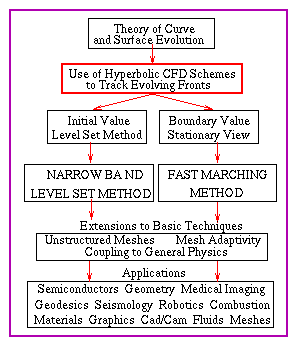OVERVIEW
APPLICATIONS
INTERACTIVE APPLETS
HISTORY OF THE METHODS/FLOW CHART
PUBLICATIONS
EDUCATIONAL MATERIAL
ACKNOWLEDGEMENTS
ABOUT THE AUTHOR/CV
Copyright:
1996, 1999, 2006
J.A. Sethian
Coupling Numerical Schemes for Hyperbolic Equations to Interface Evolution
Central Idea:
Once the
link between evolving fronts and hyperbolic conservation
laws was established,
Ref. 1 suggests the use of the numerical technology of shock schemes
to move the interface.
First, the equation of motion
for a propagating curve which remains a graph as it moves
is written as a Hamilton-Jacobi equation. It is formally
shown that this is a hyperbolic conservation law with viscous
right-hand-side. As discussed in Ref. 1 (Sethian, 1987):
"One alternative is to consider the reformulation equations
of motion as a conservation law with viscosity and solve
these equations with the techniques developed for gas
dynamics. These techniques, based on high-order upwind
formulations, are particularly attractive, since they are
highly stable, accurate, and preserve monotonicity.
We have made some preliminary tests of such schemes
applied to our problems of propagating fronts in crystals
and flames with extremely encouraging results, and will
report on this work elsewhere [17]."
In this paper, Reference [17] is listed as:
"Sethian, J.A., An algorithm for propagating fronts based
on high-order upwind schemes, in progress."
Reference[17], which was work in progress, was not submitted for
publication. Instead, the ideas in [1,2,3] contributed to the joint
Osher-Sethian level set paper,
which introduced the ideas of embedding and mulidimensional
schmes which make up the level set method.
-
An Analysis of Flame Propagation
: Sethian, J.A., PhD. Dissertation, Dept. of Mathematics, Univ. of
California, Berkeley, 1982.
-
Curvature and the Evolution of Fronts
: Sethian, J.A., Communications of Mathematical Physics,
Vol. 101, No. 4, 1985
-
Numerical Methods for Propagating Fronts
: Sethian, J.A.,
in
Variational Methods for Free Surface Interfaces,
Proceedings of the September 1985 Vallambrosa Conference,
Eds. P. Concus and R. Finn,
Springer-Verlag, NY, 1987.
"One alternative is to consider the reformulation equations of motion as a conservation law with viscosity and solve these equations with the techniques developed for gas dynamics. These techniques, based on high-order upwind formulations, are particularly attractive, since they are highly stable, accurate, and preserve monotonicity. We have made some preliminary tests of such schemes applied to our problems of propagating fronts in crystals and flames with extremely encouraging results, and will report on this work elsewhere [17]."
In this paper, Reference [17] is listed as:
"Sethian, J.A., An algorithm for propagating fronts based
on high-order upwind schemes, in progress."
Reference[17], which was work in progress, was not submitted for
publication. Instead, the ideas in [1,2,3] contributed to the joint
Osher-Sethian level set paper,
which introduced the ideas of embedding and mulidimensional
schmes which make up the level set method.
-
An Analysis of Flame Propagation
: Sethian, J.A., PhD. Dissertation, Dept. of Mathematics, Univ. of
California, Berkeley, 1982.
-
Curvature and the Evolution of Fronts
: Sethian, J.A., Communications of Mathematical Physics,
Vol. 101, No. 4, 1985
-
Numerical Methods for Propagating Fronts
: Sethian, J.A.,
in
Variational Methods for Free Surface Interfaces,
Proceedings of the September 1985 Vallambrosa Conference,
Eds. P. Concus and R. Finn,
Springer-Verlag, NY, 1987.
|
You are currently in the topic outlined in red. |

Click on navigable flow chart to go to new topic |
click on any text to go to a new topic. |
Annotated References:
Once
a theory of propagating interfaces is developed ,
and the role of curvature as
a regularizing term is established, the next step is to use the
numerical technology of shock schemes to move the interface.
This is proposed in Ref. 1 below. First, the equation of motion
for a propagating curve which remains a graph as it moves
is written as a Hamilton-Jacobi equation, and then it is formally
shown that this is a hyperbolic conservation law with viscous
right-hand-side. It then proposes to solve the original equation
using schemes borrowed from the numerical technology of
shock computations in computational fluid dynamics.
In the special case of a curve moving normal to itself with speed F = 1 - epsilon k, where epsilon is small number and "k" is the curvature, the equations of motion become a Hamilton-Jacobi equation with viscous right-hand-side Such equations are part of a general theory of viscosity solutions developed by Crandall and Lions in Refs. 2 and 3 below. This theory develops, for Hamilton-Jacobi equations of the form u_t + H(x,y,z,u_x,u_y,u_z) = 0, a rigorous analysis of what happens once singularities develop in the solution. This theory mirrors that for hyperbolic conservation laws, and provides theoretical underpinnings for some of the work on level set methods and Fast Marching Methods .
The next step is then to exploit all the previous work and now consider interfaces which do not remain graphs as they evolve.. At the same time, considerable theoretical work on viscosity solutions of Hamilton-Jacobi equations comes into play.
New Book and Resource on Level Set and Fast Marching Methods
References:
-
Numerical Methods for Propagating Fronts
: Sethian, J.A.,
in
Variational Methods for Free Surface Interfaces,
Proceedings of the Sept. 1985 Vallambrosa Conference,
Eds. P. Concus and R. Finn, Springer-Verlag, NY, 1987.
Abstract
In many physical problems, a key aspect is the motion of a propagating front separating two components. As fundamental as this may be, the development of a numerical algorithm to accurately track the moving front is difficult. In this report, we describe some previous theoretical and numerical work. We begin with two examples to motivate the problem, followed by some analytical results. These theoretical results are then used as a foundation for two different types of numerical schemes. Finally, we describe the application of one of these schemes to our work in combustion.
-
Two Approximations of Solutions of {Hamilton}-{Jacobi} Equations,
:
Crandall, M.G. and Lions, P.L.,
Math. Comp., 167, 43, pp. 1-19, 1984.
-
Viscosity Solutions of Hamilton--Jacobi Equations,
:
Crandall, M.G., and Lions, P-L.,
Tran. AMS, 277, pp. 1--43, 1983.
Download publications